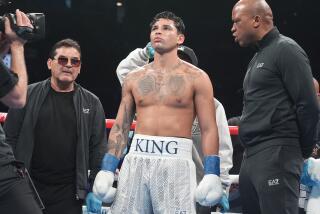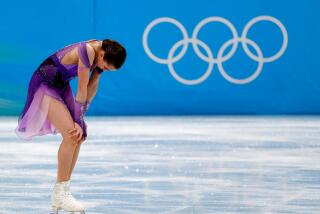Kenyan Boxer Expelled for Drug
- Share via
ATHENS — In the first of what anti-doping authorities expect to be a record number of Olympic doping offenses, a Kenyan boxer was disqualified from the 2004 Summer Games after testing positive here for a stimulant in wide use in East Africa, IOC officials said Tuesday.
David Munyasia, 24, was ordered out of the Games after testing positive Aug. 6 for cathine, a substance commonly found in khat, a brownish, leafy chew used in East Africa as chewing tobacco is used in the United States.
The test spotlights key changes in Olympic anti-doping protocols -- changes expected to produce a marked increase in doping positives.
It also followed by one day a string of positives reported from tests taken around the world in recent weeks.
Monday, it was announced that a Spanish canoeist, a Swiss cyclist and an Irish distance runner would not be coming to the Games because each had tested positive for EPO, a blood booster. Also, two Greek Americans on the Greek baseball team were blocked, pitcher A.J. Brack for a steroid and outfielder Derek Nicholson for a diuretic, which can be used to mask banned substances.
Also Monday, U.S. sprinter Bernard Williams was given a public warning after testing positive for marijuana at a meet in Spain in June. He is scheduled to compete here in the 200 meters.
Including Williams, 13 U.S. track and field athletes have been sanctioned this year after positive doping tests. More than half a dozen others have been implicated or remain under investigation by anti-doping authorities.
Officials consistently say they regret any positive test but they also say that positives indicate that testers, who for years have been involved in a cat-and-mouse game with cheaters, are making progress. If the 2004 Games produce a record number of positive tests, so be it, officials said Tuesday.
“Wouldn’t bother me,” said Dick Pound of Montreal, a longtime IOC member and head of the World Anti-Doping Agency.
Eleven athletes, six of them medalists, were disqualified at the Sydney Summer Games in 2000. In all, 10,649 athletes competed at Sydney. About that many are expected here.
But Arne Ljungqvist, the IOC’s anti-doping chief, said he expected to see more positives here, for three reasons:
* The 2004 Games are the first at which the IOC is testing for the full range of banned drugs during both the lead-up to the Olympics and the 17 days of the Games. Before, the IOC used to test for the full list only during the Games.
In the case of Munyasia, the boxer registered with Games officials on the morning of Aug. 6. He was tested at 3 that afternoon, Ljungqvist said.
“No explanation for the defense,” said Patrick Schamasch, the IOC’s medical director.
* More positives are anticipated because of enhanced testing for glucocorticosteroids, commonly found in several anti-inflammatory pills and creams.
Permission for using such drugs is available but can be granted only if athletes or team officials have filed what’s called a “therapeutic use exemption,” or TUE, explaining why such use is sought, Ljungqvist said.
Ljungqvist added that the proper paperwork in many cases has not been filed.
“If there is no TUE, we have to rule them out. Such are the rules,” he said.
* Finally, the IOC expects to conduct more than 3,000 tests here, up 25% from the Sydney Games. It began testing for EPO in Sydney and a test for human growth hormone is “perilously close,” Pound said in a recent interview.
Even if a test were now available, Ljungqvist said, authorities might not confirm its use, hoping to keep cheaters guessing.
“We don’t tell what we can and can’t test for,” he said.
More to Read
Go beyond the scoreboard
Get the latest on L.A.'s teams in the daily Sports Report newsletter.
You may occasionally receive promotional content from the Los Angeles Times.






